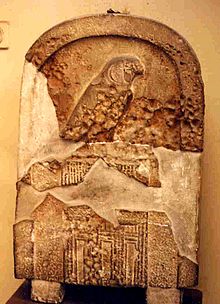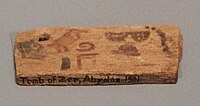Djer
| Djer | |||||||||||||||||||||||||||||||||||||||||||||||||||||||
|---|---|---|---|---|---|---|---|---|---|---|---|---|---|---|---|---|---|---|---|---|---|---|---|---|---|---|---|---|---|---|---|---|---|---|---|---|---|---|---|---|---|---|---|---|---|---|---|---|---|---|---|---|---|---|---|
| Zher, Sekhty | |||||||||||||||||||||||||||||||||||||||||||||||||||||||
 | |||||||||||||||||||||||||||||||||||||||||||||||||||||||
| Pharaoh | |||||||||||||||||||||||||||||||||||||||||||||||||||||||
| Reign | 41 years,c. 3000 BC | ||||||||||||||||||||||||||||||||||||||||||||||||||||||
| Predecessor | Hor-AhaorMenes | ||||||||||||||||||||||||||||||||||||||||||||||||||||||
| Successor | Djet | ||||||||||||||||||||||||||||||||||||||||||||||||||||||
| |||||||||||||||||||||||||||||||||||||||||||||||||||||||
| Consort | Nakhtneith,Herneith,Penebui | ||||||||||||||||||||||||||||||||||||||||||||||||||||||
| Children | Merneith,Djet? | ||||||||||||||||||||||||||||||||||||||||||||||||||||||
| Father | Hor-Aha | ||||||||||||||||||||||||||||||||||||||||||||||||||||||
| Mother | Khenthap?,Neithhotep? | ||||||||||||||||||||||||||||||||||||||||||||||||||||||
| Burial | Tomb O,Umm el-Qa'ab | ||||||||||||||||||||||||||||||||||||||||||||||||||||||
| Dynasty | middle of the 1st Dynasty | ||||||||||||||||||||||||||||||||||||||||||||||||||||||
Djer(orZerorSekhty;fl. c.3000 BC)[1]is considered the thirdpharaohof theFirst Dynastyofancient Egyptin current Egyptology. He lived around the mid31st century BC[2]and reigned for c. 40 years. A mummified forearm of Djer or his wife was discovered by EgyptologistFlinders Petrie,[3]but was discarded byÉmile Brugsch.[4]
Name[edit]

TheAbydos King Listlists the third pharaoh asIti,theTurin King Listlists a damaged name, beginning withIt...,whileManetholistsKenkenês.Jürgen von Beckerathin the Handbuch der ägyptischen Königsnamen (1999) translates the hieroglyphs of the name Djer as "Defender of Horus."[5]
Length of reign[edit]
Although the Egyptian priest Manetho, writing in the third century BC, stated that Djer ruled for 57 years, modern research by Toby Wilkinson inRoyal Annals of Ancient Egyptstresses that the near-contemporary and therefore, more accuratePalermo Stoneascribes Djer a reign of "41 complete and partial years."[6]Wilkinson notes that years 1–10 of Djer's reign are preserved inregisterII of the Palermo Stone, while the middle years of this pharaoh's reign are recorded in register II of Cairo stone fragmentC1.[7]
Reign[edit]

Djer's reign was preceded by a regency controlled byNeithhotep,possibly his mother or grandmother.
The evidence for Djer's life and reign is:[8]
- Tomb inUmm el-Qa'ab,Abydos
- Seal prints from graves 2185 and 3471 inSaqqara
- Inscriptions in graves 3503, 3506 and 3035 in Saqqara
- Seal impression and inscriptions fromHelwan[9]
- Jar from Turah with the name of Djer[10]
- UC 16182 ivory tablet from Abydos,[11]subsidiary tomb 612 of the enclosure of Djer[12]
- UC 16172 copper adze with the name of Djer[13]
- Inscription of his name (of questioned authenticity, however) atWadi Halfa,Sudan
The inscriptions, onivoryand wood, are in a very early form ofhieroglyphs,hindering complete translation, but a label at Saqqarah may depict the First Dynasty practice ofhuman sacrifice.[14]An ivory tablet fromAbydosmentions that Djer visitedButoandSaisin theNile Delta.One of his regnal years on the Cairo Stone was named "Year of smiting the land ofSetjet",which often is speculated to be Sinai or beyond.
Manethoclaimed that Athothes, who is sometimes identified as Djer, had written a treatise onanatomythat still existed in his own day, over two millennia later.[15]
Family[edit]

Djer was a son of the pharaohHor-Ahaand his wifeKhenthap.[citation needed]His grandfather was probablyNarmer.Djer fatheredMerneith,wife ofDjetand mother ofDen.Women carrying titles later associated with queens such asGreat One of the Hetes-SceptreandShe who Sees/Carries Horuswere buried in subsidiary tombs near the tomb of Djer inAbydosor attested in Saqqara. These women are thought to be the wives of Djer and include:
- Nakhtneith(or Nekhetneith), buried inAbydosand known from a stela.[16][17]
- Herneith,possibly a wife of Djer. Buried in Saqqara.[17]
- Seshemetka,buried inAbydosnext to the king.[18]She was said to be a wife of Den in Dodson and Hilton.[17]
- Penebui,her name and title were found on an ivory label from Saqqara.[16]
- bsu,known from a label in Saqqara and several stone vessels (reading of name uncertain; name consists of three fish hieroglyphs).[16]
Tomb[edit]

Similarly to his father Hor-Aha, Djer was buried inUmm el-Qa'abatAbydos.Djer's tomb is tomb O of Petrie. His tomb contains the remains of 318 retainers who were buried with him.[19]At some point, Djer's tomb was devastated by fire, possibly as early as theSecond Dynasty.[20]During theMiddle Kingdom,the tomb of Djer was revered as the tomb ofOsiris,[20]and the entire First Dynasty burial complex, which includes the tomb of Djer, was very important in the Egyptian religious tradition. An image of Osiris on a funerarybierwas placed in the tomb, possibly by theThirteenth dynastypharaohDjedkheperu.[20]
Several objects were found in and around the tomb of Djer:[21]
- A stela of Djer, now in theCairo Museum,probably comes fromAbydos.
- Labels mentioning the name of a palace and the name ofMeritneith.
- Fragments of two vases inscribed with the name of QueenNeithhotep.
- Bracelets of a Queen were found in the wall of the tomb.
In the subsidiary tombs, excavators found objects including stelae representing several individuals, ivory objects inscribed with the name ofNeithhotep,and various ivory tablets.[21]
Manetho indicates that the First Dynasty ruled fromMemphis– and indeedHerneith,one of Djer's wives, was buried nearby atSaqqara.
Gallery[edit]
-
Small ivory label of Djer mentioning the name of a fortress or domain of the king "Hor-Djer-ib".
-
Seal impression with theserekhof Djer found in Abydos, on display at theBritish Museum
-
Ceremonial flint knife with the Horus name of Djer inscribed on its gold handle, on display at theRoyal Ontario Museum.
-
Close-up view of Djer's serekh on the ceremonial flint knife of theRoyal Ontario Museum.
-
Label from Tomb of King Djer, Abydos
-
Label from Tomb of King Djer, Abydos
See also[edit]
References[edit]
- ^Trigger, Bruce(1983).Ancient Egypt: A Social History.Cambridge University Press. p. 70.ISBN978-0521284271.
- ^Grimal, Nicolas (1994).A History of Ancient Egypt.Wiley-Blackwell. p. 528.ISBN0-631-19396-0.
- ^W. M. Flinders Petrie: The Royal Tombs of the Earliest Dynasties, 1901, Part II, London 1901, p.16-17
- ^Salima Ikram and Aidan Dodson, The Mummy in Ancient Egypt: Equipping the Dead for Eternity, Thames & Hudson, 1998, p. 109
- ^Beckerath, Handbuch der ägyptischen Königsnamen (1999), 38-39, 3:H
- ^Toby Wilkinson, Royal Annals of Ancient Egypt: The Palermo Stone and Its Associated Fragments, (Kegan Paul International), 2000. p.79
- ^Wilkinson, Royal Annals of Ancient Egypt, p.258
- ^King Djerpage from digitalegypt.
- ^Saad 1947: 165; Saad 1969: 82, pl. 94
- ^Kaiser 1964: 103, fig.3
- ^"King Djer".ucl.ac.uk.RetrievedMarch 16,2024.
- ^Petrie 1925: pl. II.8; XII.1
- ^tomb 461 in Abydos, Petrie 1925: pl. III.1, IV.8
- ^Rice, MichaelThe Power of the BullRoutledge; 1 edition (4 Dec 1997)ISBN978-0-415-09032-2p123[1]
- ^"Manetho, with an English translation by W.G. Waddell".1940.
- ^abcW. Grajetzki: Ancient Egyptian Queens: a hieroglyphic dictionary
- ^abcDodson and Hilton: The Complete Royal Families of Ancient Egypt, 2004
- ^W. M. Flinders Petrie:The Royal Tombs of the Earliest Dynasties, 1901,Part II, London 1901, pl. XXVII, 96
- ^Thomas Kühn:Die Königsgräber der 1. & 2. Dynastie in Abydos.In:Kemet.Issue 1, 2008.
- ^abcBaker, Darrell D. (2008).Encyclopedia of the Pharaohs Volume 1: Predynastic to the Twentieth DYnasty 3300-1069 BC.Egypt: The American University in Cairo Press. p. 93.
- ^abB. Porter and R.L.B. Moss. Topographical Bibliography of Ancient Egyptian Hieroglyphic Texts, Reliefs, and Paintings, V. Upper Egypt: Sites. Oxford, 1937
Bibliography[edit]
- Toby A. H. Wilkinson,Early Dynastic Egypt,Routledge, London/New York 1999,ISBN0-415-18633-1,71-73
- Toby Wilkinson, Royal Annals of Ancient Egypt: The Palermo Stone and Its Associated Fragments, (Kegan Paul International), 2000.
External links[edit]
![]() Media related toDjerat Wikimedia Commons
Media related toDjerat Wikimedia Commons








